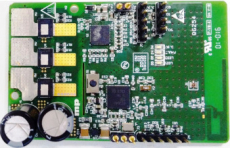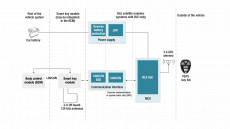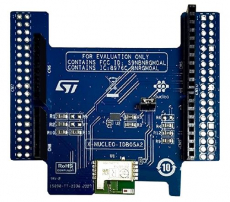Sidebar
按标签筛选文章: Bluetooth Low Energy
星期五, 27 05月 2022 07:26
Bluetooth Low Energy Communication
Bluetooth Low Energy (formerly known as Bluetooth Smart) is a wireless communication protocol that uses Bluetooth with low-power peripheral devices. These peripheral devices include fitness trackers, health monitors, and personal electronics such as smartwatches or wireless headphones.
星期五, 20 08月 2021 09:12
Memory in Bluetooth Low Energy Development
Get to know the differences between memory options and the trade-offs you need to make when working with Bluetooth Low Energy development projects.
栏目
Nordic
星期日, 04 04月 2021 17:08
Bluetooth 4.2 Low Energy Protocol Stack for Renesas RL78/G1D
Bluetooth® low energy Protocol Stack is equipped with the standard profile API and custom profile mountable API. Moreover, it supports embedded and modem configurations.
Application Examples
Application Examples
栏目
低功耗协议栈
星期日, 11 10月 2020 18:25
ST BlueNRG-LP:Programmable Bluetooth® Low Energy Wireless SoC
The BlueNRG-LP is an ultra-low power programmable Bluetooth® Low Energy wireless SoC solution. It embeds STMicroelectronics’s state-of-art 2.4 GHz RF radio IPs combining unparalleled performance with extremely long-battery lifetime. It is compliant with Bluetooth® Low Energy SIG core specification version 5.2 addressing point-to-point connectivity and Bluetooth Mesh networking and allows large-scale device networks to be established in a reliable way. The BlueNRG-LP is also suitable for 2.4 GHz proprietary radio wireless communication to address ultra-low latency applications.
栏目
蓝牙芯片
星期一, 28 09月 2020 21:03
Ti:Microcontroller 18-V/600-W BLDC Motor Control Reference Design With Bluetooth® Low Energy 5.0
This reference design offers a Bluetooth® 5.0 SimpleLink™ option with better industrial noise immunity, more range, and less power for industrial applications such as power tools that operate from a 5- cell Li-ion battery. This power stage reference design uses a single Bluetooth low energy (BLE) MCU for both wireless connectivity and three-phase brushless DC (BLDC) motor trapezoidal control, designed in a single board, reducing the BOM and hence overall cost. The design demonstrates the BLE RX sensitivity of –96 dBm even when the power stage is driving motor, showing the robustness of RF performance. The design also demonstrates a small form factor power stage with overcurrent and short-circuit protection by MOSFET VDS sensing.
栏目
技术文章
星期六, 26 09月 2020 16:53
Ti:Car access Bluetooth® low energy + CAN satellite module reference design
This satellite module reference design is intended for Bluetooth® low energy passive entry passive start (PEPS) and phone as a key / digital key car access systems. The design demonstrates how control area network flexible data rate (CAN-FD) communication capabilities can be implemented with our Bluetooth wireless MCUs for systems that require higher bandwidth in-vehicle networking communications. Further benefits include reduced power consumption in the sleep state, our CAN auto-addressing method for improved manufacturing, connection monitor capabilities for improved Bluetooth localization accuracy and a compact printed-circuit board (PCB) capable of measuring Bluetooth angle of arrival (AoA) and received signal strength index (RSSI).
Ti integrated circuits and reference designs help you design passive entry passive start (PEPS) modules and key fobs that are secure and compact while reducing system power consumption and optimizing RF and vehicle
栏目
技术文章
星期二, 22 09月 2020 00:11
Renesas Bluetooth® Low Energy RA4W1 Solutions
Bluetooth® Low Energy Wireless Solution to Accelerate Realization of IoT of Embedded Devices.
Single chip Bluetooth® 5.0 Low Energy application controller using popular ARM Cortex M4 core with dedicated Secure Crypto Engine
栏目
技术文章
星期六, 19 09月 2020 12:51
Ti SimpleLink Bluetooth® Low Energy wireless MCUs
栏目
蓝牙模块
星期五, 18 09月 2020 23:17
STMicroelectronics Bluetooth low energy expansion board based on the BlueNRG-M0 module for STM32 Nucleo X-NUCLEO-IDB05A2
The X-NUCLEO-IDB05A2 Bluetooth low energy expansion board is based on the BlueNRG-M0 BLE network processor module.
The BlueNRG-M0 is Bluetooth v4.2 compliant, FCC and IC certified (FCC ID: S9NBNRGM0AL; IC: 8976C-BNRGM0AL). It supports simultaneous master/slave roles and can behave as a Bluetooth low energy sensor and hub device at the same time.
The BlueNRG-M0 provides a complete RF platform in a tiny form factor, with integrated radio, antenna, high frequency and LPO oscillators.
The X-NUCLEO-IDB05A2 is compatible with the ST morpho (not mounted) and Arduino UNO R3 connector layout.
The X-NUCLEO-IDB05A2 interfaces with the STM32 microcontroller via the SPI pin and allows changing the default SPI clock, SPI chip select and SPI IRQ by replacing a resistor on the expansion board.
栏目
开发板




